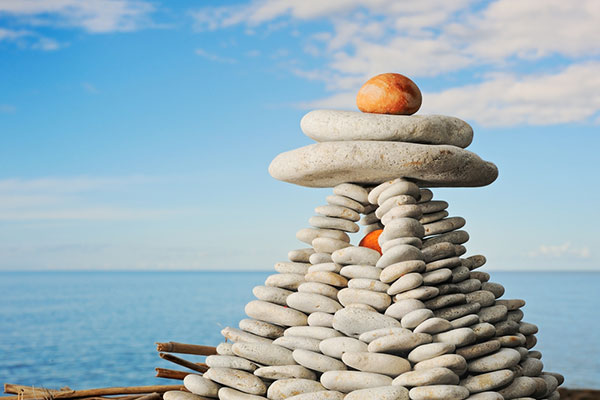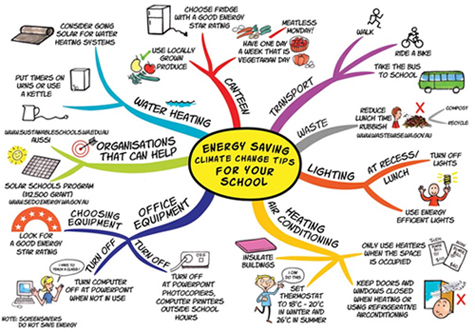“A rock pile ceases to be a rock pile the moment a single man contemplates it, bearing within him the image of a cathedral.”
~Antoine de Saint-Exupery
Daniel Pink, creativity expert and author of A Whole New Mind: Why Right-Brainers Will Rule the Future, says we are entering a new era – a conceptual era – where right brain abilities such as artistry, empathy, inventiveness, and big-picture thinking will be just as important as the left brain’s logical, linear and by-the-number abilities. Traditionally, left brain skills mattered more, Pink says, and still do, however they are not enough. He says you need both sides of the brain, both approaches, to craft a fulfilling life.
With a growing emphasis and value on creativity, the good news is that anyone can tap into its power. Here are 10 ways to spark your creative genius:
1. Explore the Unknown
Routine and habit can squash creativity and stifle us. Once stifled, our minds are not challenged anymore. To break the routine, do things you’ve never done before. Take a ride in a hot air balloon, throw a block party, sign-up for a writing or painting course, take a day trip somewhere, draw pictures, talk to someone new or try a new recipe.
How about reading books other than the usual? We tend to stick with what we like. If you only read non-fiction books then you can be missing out on amazing fiction books and vice versa. Choose an activity that thrills, inspires, or even scares you. When we take ourselves out of our comfort zone, pushing through our fears, we liberate ourselves, gain new perspectives and expand our creative minds.
2. Write Morning Pages
Author and artist Julia Cameron in her book, The Artists Way: A Spiritual Path to Higher Creativity, recommends a basic tool for a “lasting creative awakening” called “Morning Pages”. These three pages of longhand writing, as Cameron says, are strictly a stream-of-consciousness, whatever crosses the mind. She explains that the pages must be done in the morning because they prioritize the day you are about to have instead of reviewing the day that’s already past. Cameron says there is no wrong way of doing the morning pages and nothing written is too petty, silly, stupid, negative, or weird. The purpose of this brain dumping, she explains, is to get all that “angry, whiny, petty stuff” written down so that it miniaturizes our censor, calming us down, cheering us up, inspiring us, consoling us and emptying ourselves of disturbing distractions. Consequently, our minds and hearts open up to deeper reflections.
3. Keep an Idea Book
Ever had an idea come to you in a dream, during the ride to work, or in the shower? Great ideas can come unexpectedly so it’s important to write them down so as not to forget. Keeping an idea book handy can help to capture a thought or idea in the moment. The idea book can hold bits of wisdom, observations, and inspiring words, for example. It can be used as a brainstorming tool. Carry your idea book in your pocket or purse and have another book near your bedside. Just as long as it can be easily accessed when that inspiring idea comes.
4. Use Mind Maps
Mind mapping is a creative tool that can help solve problems by visually connecting thoughts, ideas and facts just as the mind works. They can be used for creative-problem solving, decision-making, project planning, brainstorming, and taking notes. A mind map is a diagram that includes the arranging of words, ideas and activities linked to a central idea. The goal is to organize and classify information visually to quickly identify and understand the structure of a topic and how all the pieces fit together.
Think of a question or problem you have been struggling with and experiment with mind mapping. The activity in and of itself can be a creative one. For example, below is a mind map that answers the question/problem, “What can schools do about climate change?” by Sharon Genoese.
5. Design an Environment that Encourages Creativity
We can feel most inspired when we surround ourselves with the things we love and that fill our soul such as meaningful photographs, beautiful artwork, inspiring artifacts, soothing color schemes, and so on. Denise Linn in her book, Feng Shui for the Soul: How to Create a Harmonious Environment that will Nurture and Sustain You writes, “Our homes have an enormous impact on our state of mind. They can make us feel as though we are plunging into the depths of despair, or they can be uplifting havens of beauty and rejuvenation. I believe the soul yearns for places of sanctuary and balance, ones that provide authentic reminders of what is truly important in life.”
Imagine yourself in a room with comfy furniture, cherished mementos, thought-provoking artwork, peaceful and happy colors, soothing lighting or candles, and your favorite music playing in the background. You’ll be well on your way to inspired creativity.
6. Write a List of 100
Writing a list of 100 things is a powerful technique, according to Luciano Passuello, founder of the website Liteminds a simple principle where you state your question or issue at the top of a blank sheet of paper, and then you create a list of one hundred answers or solutions. The benefit, he says, of creating this list is that your subconscious starts to engage in the process, ideas start flow, uncovering new and surprising answers.
“The List of 100 is a beautifully articulated cooperation between the conscious and subconscious minds tackling one single problem,” Passuello says. He emphasizes that the list must be done in one sitting for it to work properly with no distractions. He says to do the following as you write the list:
- Don’t judge or evaluate ideas; you’ll review them later.
- Don’t write complete words or sentences, if that slows you down.
- Don’t stop to wonder how far in the list you are; number the lines from 1 to 100 in advance or use numbered lists if you’re using a word processor.
- Don’t worry too much about repeating entries; duplicates can shed light on your patterns of thought.
Here are some List of 100 examples: 100 Ways to Generate Income, 100 Things I Am Grateful For, 100 Ways to Improve My Relationships, and 100 Places I’d Like to Visit.
7. Find Your Muse
What gives you inspiration and fires up your imagination? For some it’s music, perhaps a particular kind like jazz or country. For others, it may be looking at a photo, picture or symbol. Perhaps it could be communing with nature, reading a certain passage or quote. Inspiration comes in many forms and it’s important for us to know what gets our creative juices flowing. Whatever it is, use the stimulating tool of choice to inspire your creativity.
8. Create a Vision Board
A vision board is where images and words are displayed that represent who you are or want to be, do or have in your life. Creating a vision board helps identify your intentions, keeps you focused on these intentions and then helps to make them a reality. Vision boards can be created for all kinds of uses such as a particular project or outlining your life’s dreams. The vision board is a way of getting thoughts, goals and desires on paper to add clarity and to make more indelible on the mind. Keep the board in a place where it can be viewed daily. The more you look and contemplate on your board, the more your wishes enter into your subconscious, manifest and become reality. Read a great article by Christine Kane on how to make a vision board.
9. Exercise Your Imagination
When Michelangelo described how his Statue of David was created he said, “I saw the angel in the marble and carved until I set him free.” Michelangelo, through mental imagery, birthed a genius creation.
Visualization or imagination is the source for all that is created, so the more we visualize something we want to create, the more likely it will get created. Henry David Thoreau said, “The world is but a canvas to the imagination.” To live a creative life, start to imagine things such as what it is you desire in life, what life will look like when your goals and dreams are reached, and how it will feel. Visualizing has a powerful effect on the subconscious.
10. Engage in Creative Practices
Creative ideas can change the world. Life is full of possibilities, and we can realize our creative potential from writing a screenplay or a book to designing a revolutionary product or finding a cure for a disease. The only real limitations to this potential are self-imposed. Once a person can get past fear, creativity can flourish.








Great post, 10 Ways to Spark Creative Thinking I find myself often times stuck in the preverbal writer’s block. I know that God has blessed me with creative ideas these steps are great ways for me to tap into new uncharted mind ideas!